Engineering Risk Management: Queen's Wharf Project Risk Analysis
VerifiedAdded on 2023/06/13
|30
|6433
|454
Report
AI Summary
This report details a risk management plan for the Queen's Wharf Brisbane project, developed by Destination Brisbane Consortium in accordance with AS/NZS ISO 31000:2009. It covers project details, communication and consultation strategies, and establishes the internal and external contexts for risk management. The report identifies, analyzes, and evaluates 15 potential risks using methods like FMEA and qualitative risk assessment, ultimately selecting six key risks—water contamination, asbestos, airborne toxins, unintended collapse, working at height, and manual handling—for further treatment. It also outlines probable treatment options and a monitoring and review plan to ensure effective risk management throughout the project's lifecycle. The risk manager will oversee risk closure based on predetermined criteria.
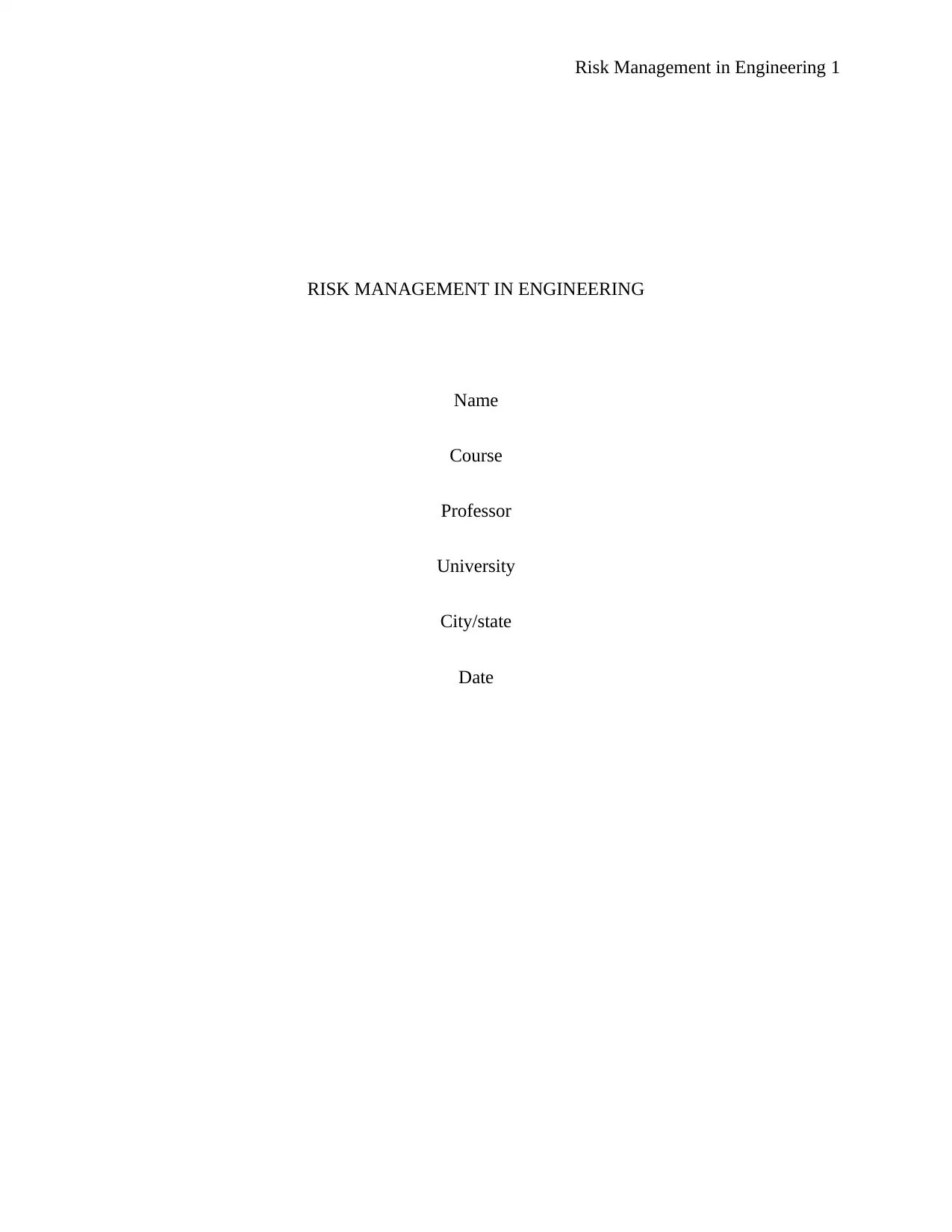
Risk Management in Engineering 1
RISK MANAGEMENT IN ENGINEERING
Name
Course
Professor
University
City/state
Date
RISK MANAGEMENT IN ENGINEERING
Name
Course
Professor
University
City/state
Date
Paraphrase This Document
Need a fresh take? Get an instant paraphrase of this document with our AI Paraphraser
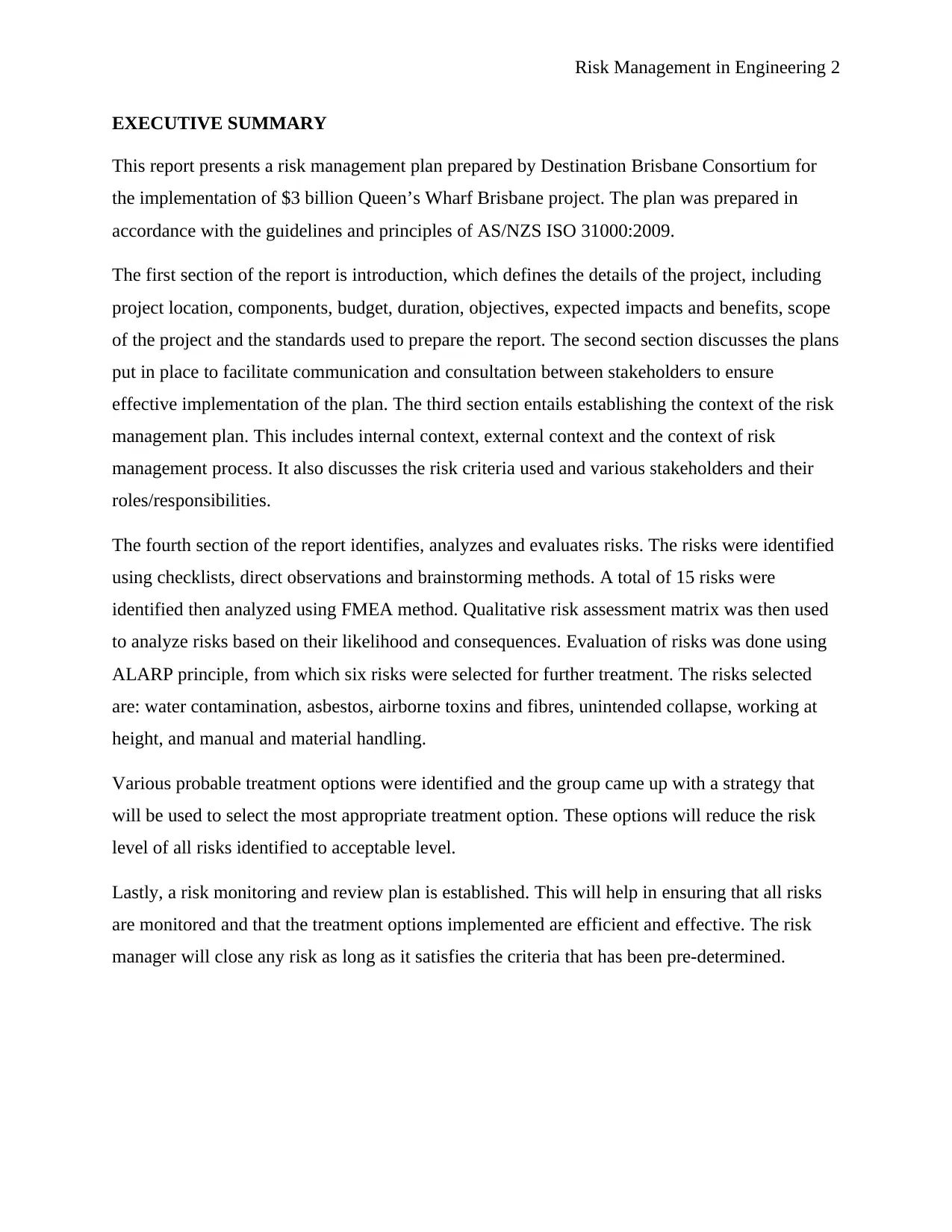
Risk Management in Engineering 2
EXECUTIVE SUMMARY
This report presents a risk management plan prepared by Destination Brisbane Consortium for
the implementation of $3 billion Queen’s Wharf Brisbane project. The plan was prepared in
accordance with the guidelines and principles of AS/NZS ISO 31000:2009.
The first section of the report is introduction, which defines the details of the project, including
project location, components, budget, duration, objectives, expected impacts and benefits, scope
of the project and the standards used to prepare the report. The second section discusses the plans
put in place to facilitate communication and consultation between stakeholders to ensure
effective implementation of the plan. The third section entails establishing the context of the risk
management plan. This includes internal context, external context and the context of risk
management process. It also discusses the risk criteria used and various stakeholders and their
roles/responsibilities.
The fourth section of the report identifies, analyzes and evaluates risks. The risks were identified
using checklists, direct observations and brainstorming methods. A total of 15 risks were
identified then analyzed using FMEA method. Qualitative risk assessment matrix was then used
to analyze risks based on their likelihood and consequences. Evaluation of risks was done using
ALARP principle, from which six risks were selected for further treatment. The risks selected
are: water contamination, asbestos, airborne toxins and fibres, unintended collapse, working at
height, and manual and material handling.
Various probable treatment options were identified and the group came up with a strategy that
will be used to select the most appropriate treatment option. These options will reduce the risk
level of all risks identified to acceptable level.
Lastly, a risk monitoring and review plan is established. This will help in ensuring that all risks
are monitored and that the treatment options implemented are efficient and effective. The risk
manager will close any risk as long as it satisfies the criteria that has been pre-determined.
EXECUTIVE SUMMARY
This report presents a risk management plan prepared by Destination Brisbane Consortium for
the implementation of $3 billion Queen’s Wharf Brisbane project. The plan was prepared in
accordance with the guidelines and principles of AS/NZS ISO 31000:2009.
The first section of the report is introduction, which defines the details of the project, including
project location, components, budget, duration, objectives, expected impacts and benefits, scope
of the project and the standards used to prepare the report. The second section discusses the plans
put in place to facilitate communication and consultation between stakeholders to ensure
effective implementation of the plan. The third section entails establishing the context of the risk
management plan. This includes internal context, external context and the context of risk
management process. It also discusses the risk criteria used and various stakeholders and their
roles/responsibilities.
The fourth section of the report identifies, analyzes and evaluates risks. The risks were identified
using checklists, direct observations and brainstorming methods. A total of 15 risks were
identified then analyzed using FMEA method. Qualitative risk assessment matrix was then used
to analyze risks based on their likelihood and consequences. Evaluation of risks was done using
ALARP principle, from which six risks were selected for further treatment. The risks selected
are: water contamination, asbestos, airborne toxins and fibres, unintended collapse, working at
height, and manual and material handling.
Various probable treatment options were identified and the group came up with a strategy that
will be used to select the most appropriate treatment option. These options will reduce the risk
level of all risks identified to acceptable level.
Lastly, a risk monitoring and review plan is established. This will help in ensuring that all risks
are monitored and that the treatment options implemented are efficient and effective. The risk
manager will close any risk as long as it satisfies the criteria that has been pre-determined.
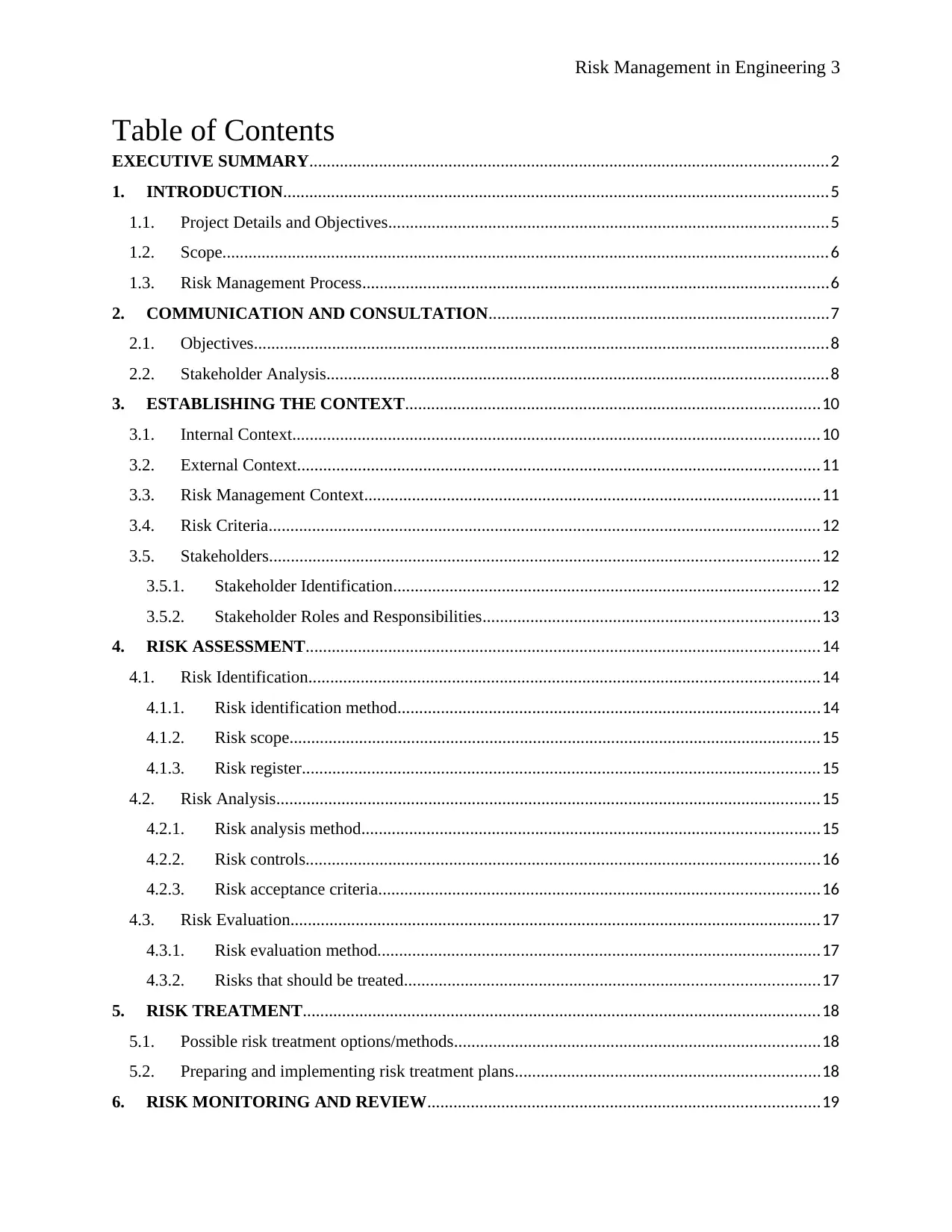
Risk Management in Engineering 3
Table of Contents
EXECUTIVE SUMMARY.......................................................................................................................2
1. INTRODUCTION.............................................................................................................................5
1.1. Project Details and Objectives.....................................................................................................5
1.2. Scope...........................................................................................................................................6
1.3. Risk Management Process...........................................................................................................6
2. COMMUNICATION AND CONSULTATION..............................................................................7
2.1. Objectives....................................................................................................................................8
2.2. Stakeholder Analysis...................................................................................................................8
3. ESTABLISHING THE CONTEXT...............................................................................................10
3.1. Internal Context.........................................................................................................................10
3.2. External Context........................................................................................................................11
3.3. Risk Management Context.........................................................................................................11
3.4. Risk Criteria...............................................................................................................................12
3.5. Stakeholders..............................................................................................................................12
3.5.1. Stakeholder Identification..................................................................................................12
3.5.2. Stakeholder Roles and Responsibilities.............................................................................13
4. RISK ASSESSMENT......................................................................................................................14
4.1. Risk Identification.....................................................................................................................14
4.1.1. Risk identification method.................................................................................................14
4.1.2. Risk scope..........................................................................................................................15
4.1.3. Risk register.......................................................................................................................15
4.2. Risk Analysis.............................................................................................................................15
4.2.1. Risk analysis method.........................................................................................................15
4.2.2. Risk controls......................................................................................................................16
4.2.3. Risk acceptance criteria.....................................................................................................16
4.3. Risk Evaluation..........................................................................................................................17
4.3.1. Risk evaluation method......................................................................................................17
4.3.2. Risks that should be treated...............................................................................................17
5. RISK TREATMENT.......................................................................................................................18
5.1. Possible risk treatment options/methods....................................................................................18
5.2. Preparing and implementing risk treatment plans......................................................................18
6. RISK MONITORING AND REVIEW..........................................................................................19
Table of Contents
EXECUTIVE SUMMARY.......................................................................................................................2
1. INTRODUCTION.............................................................................................................................5
1.1. Project Details and Objectives.....................................................................................................5
1.2. Scope...........................................................................................................................................6
1.3. Risk Management Process...........................................................................................................6
2. COMMUNICATION AND CONSULTATION..............................................................................7
2.1. Objectives....................................................................................................................................8
2.2. Stakeholder Analysis...................................................................................................................8
3. ESTABLISHING THE CONTEXT...............................................................................................10
3.1. Internal Context.........................................................................................................................10
3.2. External Context........................................................................................................................11
3.3. Risk Management Context.........................................................................................................11
3.4. Risk Criteria...............................................................................................................................12
3.5. Stakeholders..............................................................................................................................12
3.5.1. Stakeholder Identification..................................................................................................12
3.5.2. Stakeholder Roles and Responsibilities.............................................................................13
4. RISK ASSESSMENT......................................................................................................................14
4.1. Risk Identification.....................................................................................................................14
4.1.1. Risk identification method.................................................................................................14
4.1.2. Risk scope..........................................................................................................................15
4.1.3. Risk register.......................................................................................................................15
4.2. Risk Analysis.............................................................................................................................15
4.2.1. Risk analysis method.........................................................................................................15
4.2.2. Risk controls......................................................................................................................16
4.2.3. Risk acceptance criteria.....................................................................................................16
4.3. Risk Evaluation..........................................................................................................................17
4.3.1. Risk evaluation method......................................................................................................17
4.3.2. Risks that should be treated...............................................................................................17
5. RISK TREATMENT.......................................................................................................................18
5.1. Possible risk treatment options/methods....................................................................................18
5.2. Preparing and implementing risk treatment plans......................................................................18
6. RISK MONITORING AND REVIEW..........................................................................................19
⊘ This is a preview!⊘
Do you want full access?
Subscribe today to unlock all pages.

Trusted by 1+ million students worldwide
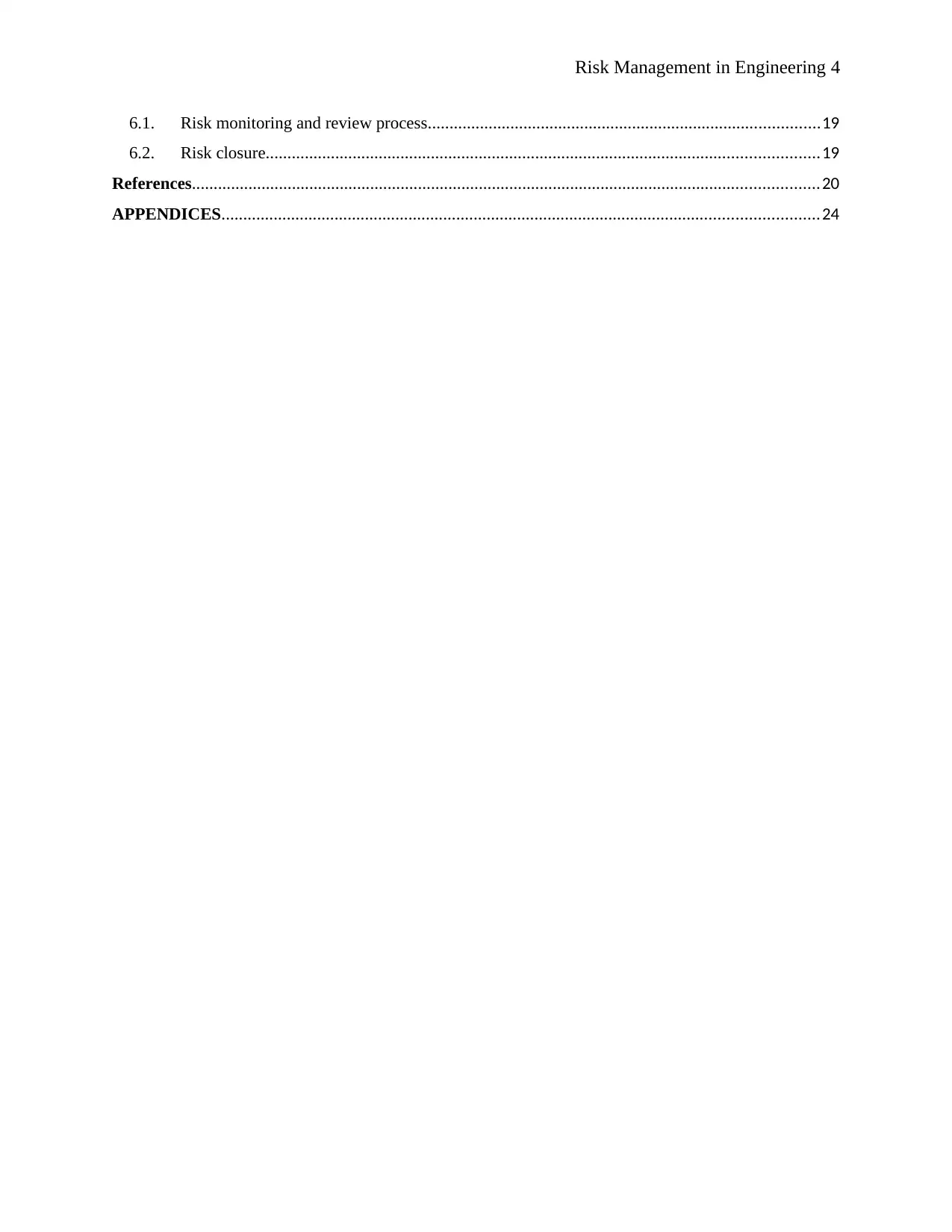
Risk Management in Engineering 4
6.1. Risk monitoring and review process..........................................................................................19
6.2. Risk closure...............................................................................................................................19
References................................................................................................................................................20
APPENDICES.........................................................................................................................................24
6.1. Risk monitoring and review process..........................................................................................19
6.2. Risk closure...............................................................................................................................19
References................................................................................................................................................20
APPENDICES.........................................................................................................................................24
Paraphrase This Document
Need a fresh take? Get an instant paraphrase of this document with our AI Paraphraser
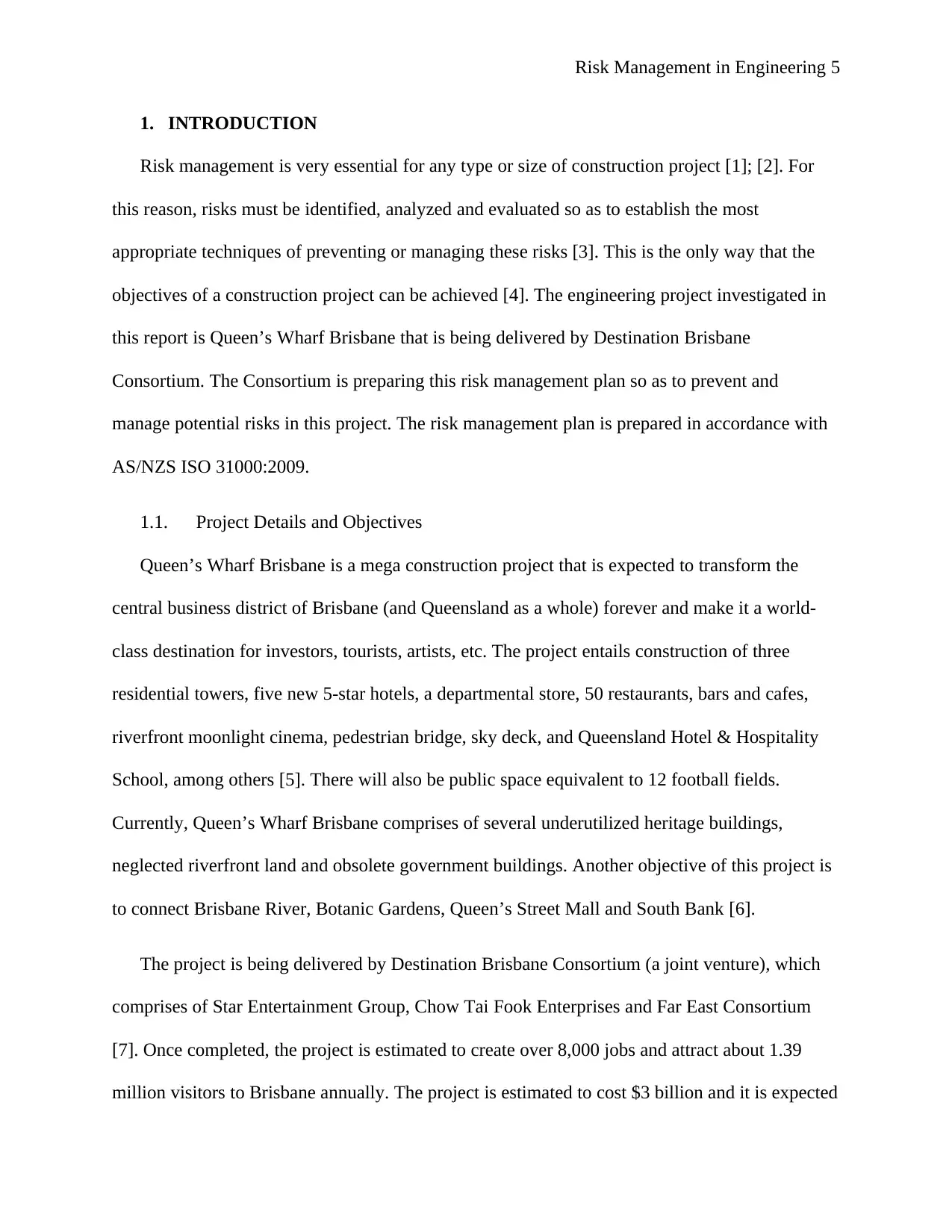
Risk Management in Engineering 5
1. INTRODUCTION
Risk management is very essential for any type or size of construction project [1]; [2]. For
this reason, risks must be identified, analyzed and evaluated so as to establish the most
appropriate techniques of preventing or managing these risks [3]. This is the only way that the
objectives of a construction project can be achieved [4]. The engineering project investigated in
this report is Queen’s Wharf Brisbane that is being delivered by Destination Brisbane
Consortium. The Consortium is preparing this risk management plan so as to prevent and
manage potential risks in this project. The risk management plan is prepared in accordance with
AS/NZS ISO 31000:2009.
1.1. Project Details and Objectives
Queen’s Wharf Brisbane is a mega construction project that is expected to transform the
central business district of Brisbane (and Queensland as a whole) forever and make it a world-
class destination for investors, tourists, artists, etc. The project entails construction of three
residential towers, five new 5-star hotels, a departmental store, 50 restaurants, bars and cafes,
riverfront moonlight cinema, pedestrian bridge, sky deck, and Queensland Hotel & Hospitality
School, among others [5]. There will also be public space equivalent to 12 football fields.
Currently, Queen’s Wharf Brisbane comprises of several underutilized heritage buildings,
neglected riverfront land and obsolete government buildings. Another objective of this project is
to connect Brisbane River, Botanic Gardens, Queen’s Street Mall and South Bank [6].
The project is being delivered by Destination Brisbane Consortium (a joint venture), which
comprises of Star Entertainment Group, Chow Tai Fook Enterprises and Far East Consortium
[7]. Once completed, the project is estimated to create over 8,000 jobs and attract about 1.39
million visitors to Brisbane annually. The project is estimated to cost $3 billion and it is expected
1. INTRODUCTION
Risk management is very essential for any type or size of construction project [1]; [2]. For
this reason, risks must be identified, analyzed and evaluated so as to establish the most
appropriate techniques of preventing or managing these risks [3]. This is the only way that the
objectives of a construction project can be achieved [4]. The engineering project investigated in
this report is Queen’s Wharf Brisbane that is being delivered by Destination Brisbane
Consortium. The Consortium is preparing this risk management plan so as to prevent and
manage potential risks in this project. The risk management plan is prepared in accordance with
AS/NZS ISO 31000:2009.
1.1. Project Details and Objectives
Queen’s Wharf Brisbane is a mega construction project that is expected to transform the
central business district of Brisbane (and Queensland as a whole) forever and make it a world-
class destination for investors, tourists, artists, etc. The project entails construction of three
residential towers, five new 5-star hotels, a departmental store, 50 restaurants, bars and cafes,
riverfront moonlight cinema, pedestrian bridge, sky deck, and Queensland Hotel & Hospitality
School, among others [5]. There will also be public space equivalent to 12 football fields.
Currently, Queen’s Wharf Brisbane comprises of several underutilized heritage buildings,
neglected riverfront land and obsolete government buildings. Another objective of this project is
to connect Brisbane River, Botanic Gardens, Queen’s Street Mall and South Bank [6].
The project is being delivered by Destination Brisbane Consortium (a joint venture), which
comprises of Star Entertainment Group, Chow Tai Fook Enterprises and Far East Consortium
[7]. Once completed, the project is estimated to create over 8,000 jobs and attract about 1.39
million visitors to Brisbane annually. The project is estimated to cost $3 billion and it is expected
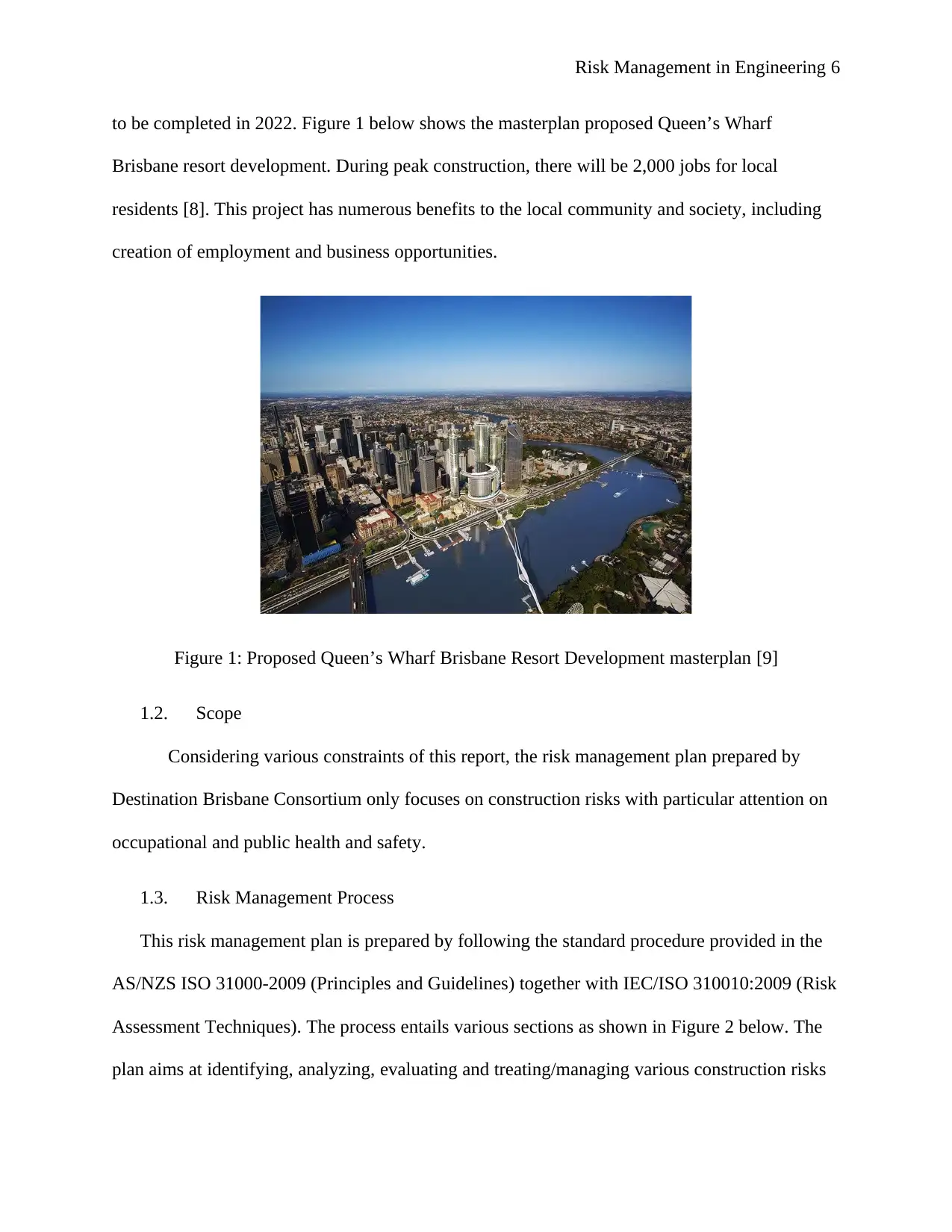
Risk Management in Engineering 6
to be completed in 2022. Figure 1 below shows the masterplan proposed Queen’s Wharf
Brisbane resort development. During peak construction, there will be 2,000 jobs for local
residents [8]. This project has numerous benefits to the local community and society, including
creation of employment and business opportunities.
Figure 1: Proposed Queen’s Wharf Brisbane Resort Development masterplan [9]
1.2. Scope
Considering various constraints of this report, the risk management plan prepared by
Destination Brisbane Consortium only focuses on construction risks with particular attention on
occupational and public health and safety.
1.3. Risk Management Process
This risk management plan is prepared by following the standard procedure provided in the
AS/NZS ISO 31000-2009 (Principles and Guidelines) together with IEC/ISO 310010:2009 (Risk
Assessment Techniques). The process entails various sections as shown in Figure 2 below. The
plan aims at identifying, analyzing, evaluating and treating/managing various construction risks
to be completed in 2022. Figure 1 below shows the masterplan proposed Queen’s Wharf
Brisbane resort development. During peak construction, there will be 2,000 jobs for local
residents [8]. This project has numerous benefits to the local community and society, including
creation of employment and business opportunities.
Figure 1: Proposed Queen’s Wharf Brisbane Resort Development masterplan [9]
1.2. Scope
Considering various constraints of this report, the risk management plan prepared by
Destination Brisbane Consortium only focuses on construction risks with particular attention on
occupational and public health and safety.
1.3. Risk Management Process
This risk management plan is prepared by following the standard procedure provided in the
AS/NZS ISO 31000-2009 (Principles and Guidelines) together with IEC/ISO 310010:2009 (Risk
Assessment Techniques). The process entails various sections as shown in Figure 2 below. The
plan aims at identifying, analyzing, evaluating and treating/managing various construction risks
⊘ This is a preview!⊘
Do you want full access?
Subscribe today to unlock all pages.

Trusted by 1+ million students worldwide
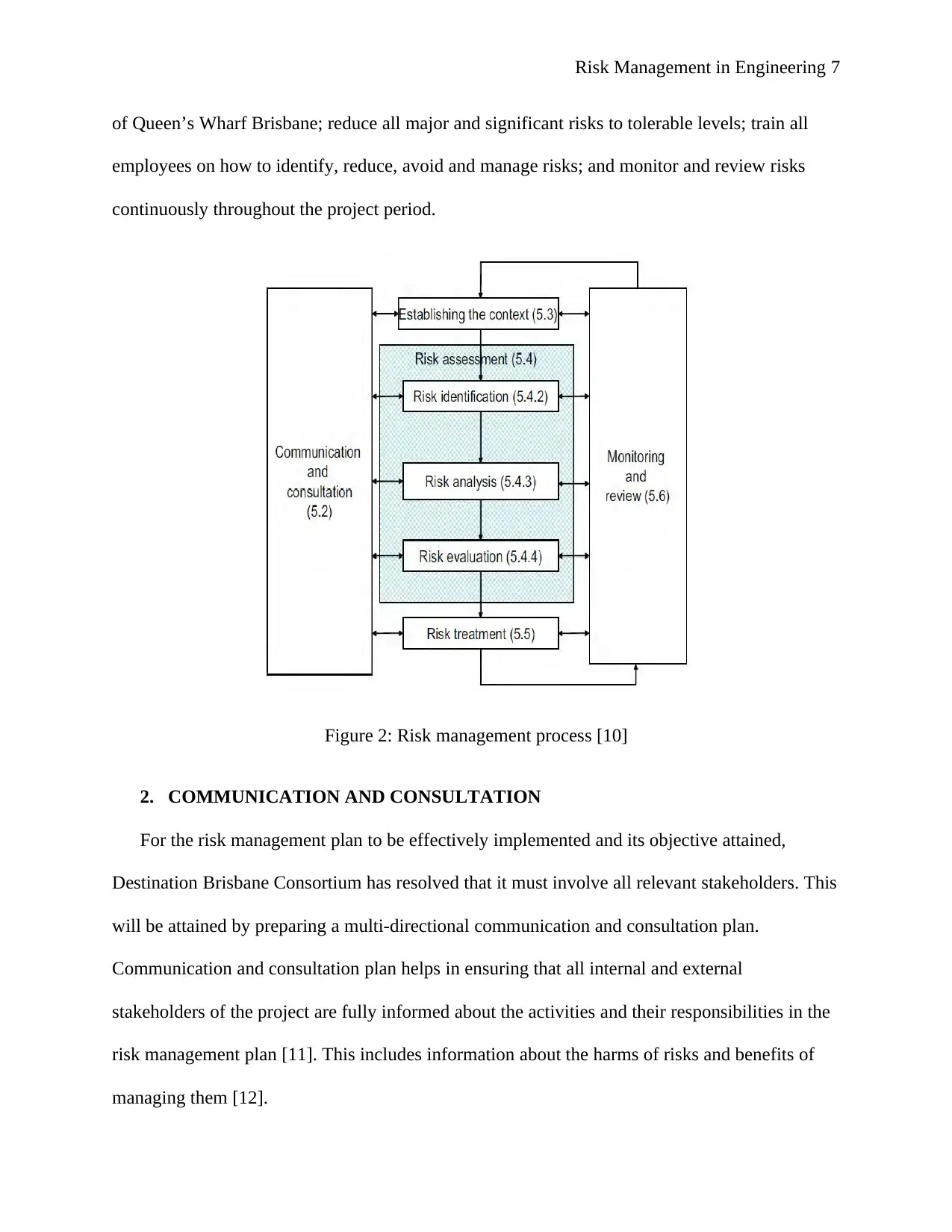
Risk Management in Engineering 7
of Queen’s Wharf Brisbane; reduce all major and significant risks to tolerable levels; train all
employees on how to identify, reduce, avoid and manage risks; and monitor and review risks
continuously throughout the project period.
Figure 2: Risk management process [10]
2. COMMUNICATION AND CONSULTATION
For the risk management plan to be effectively implemented and its objective attained,
Destination Brisbane Consortium has resolved that it must involve all relevant stakeholders. This
will be attained by preparing a multi-directional communication and consultation plan.
Communication and consultation plan helps in ensuring that all internal and external
stakeholders of the project are fully informed about the activities and their responsibilities in the
risk management plan [11]. This includes information about the harms of risks and benefits of
managing them [12].
of Queen’s Wharf Brisbane; reduce all major and significant risks to tolerable levels; train all
employees on how to identify, reduce, avoid and manage risks; and monitor and review risks
continuously throughout the project period.
Figure 2: Risk management process [10]
2. COMMUNICATION AND CONSULTATION
For the risk management plan to be effectively implemented and its objective attained,
Destination Brisbane Consortium has resolved that it must involve all relevant stakeholders. This
will be attained by preparing a multi-directional communication and consultation plan.
Communication and consultation plan helps in ensuring that all internal and external
stakeholders of the project are fully informed about the activities and their responsibilities in the
risk management plan [11]. This includes information about the harms of risks and benefits of
managing them [12].
Paraphrase This Document
Need a fresh take? Get an instant paraphrase of this document with our AI Paraphraser
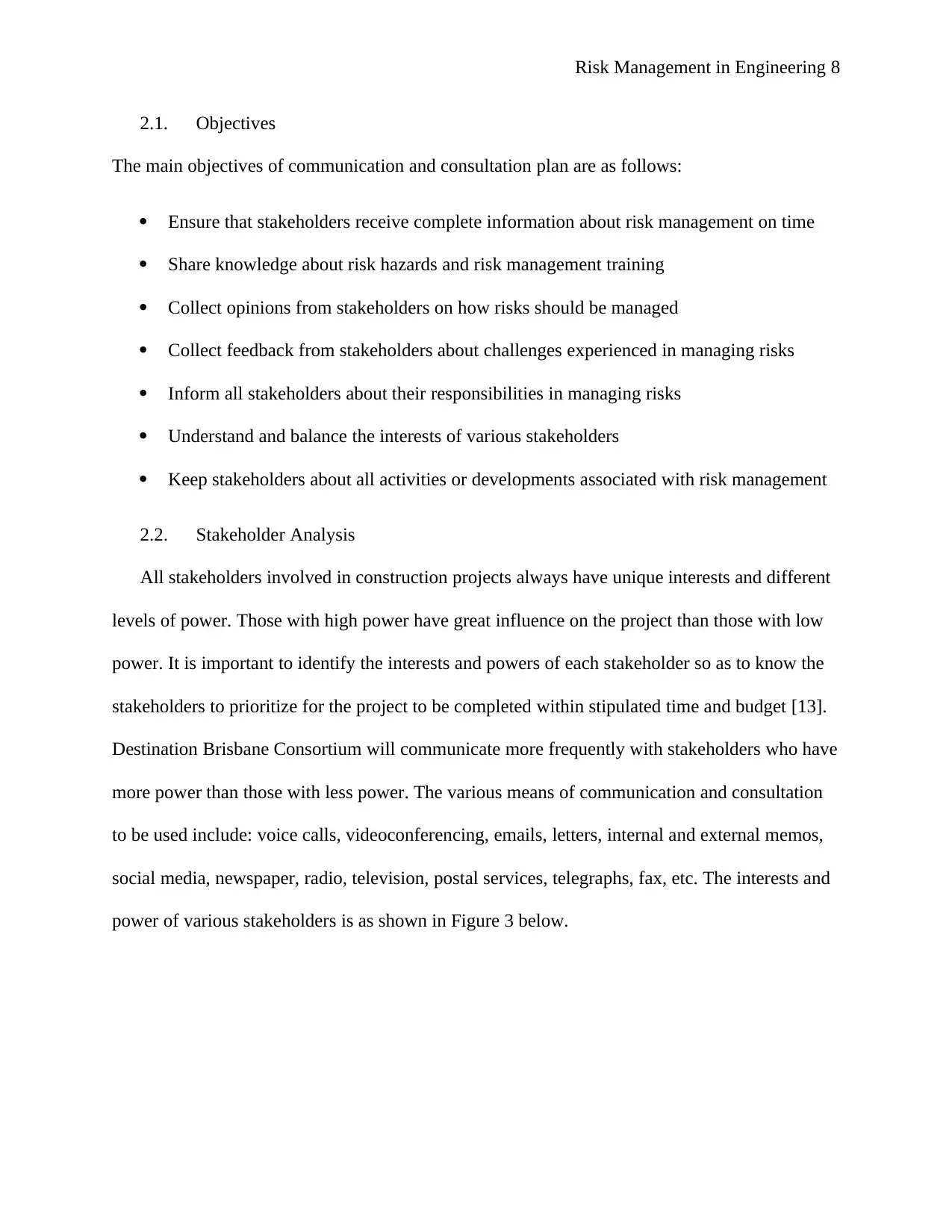
Risk Management in Engineering 8
2.1. Objectives
The main objectives of communication and consultation plan are as follows:
Ensure that stakeholders receive complete information about risk management on time
Share knowledge about risk hazards and risk management training
Collect opinions from stakeholders on how risks should be managed
Collect feedback from stakeholders about challenges experienced in managing risks
Inform all stakeholders about their responsibilities in managing risks
Understand and balance the interests of various stakeholders
Keep stakeholders about all activities or developments associated with risk management
2.2. Stakeholder Analysis
All stakeholders involved in construction projects always have unique interests and different
levels of power. Those with high power have great influence on the project than those with low
power. It is important to identify the interests and powers of each stakeholder so as to know the
stakeholders to prioritize for the project to be completed within stipulated time and budget [13].
Destination Brisbane Consortium will communicate more frequently with stakeholders who have
more power than those with less power. The various means of communication and consultation
to be used include: voice calls, videoconferencing, emails, letters, internal and external memos,
social media, newspaper, radio, television, postal services, telegraphs, fax, etc. The interests and
power of various stakeholders is as shown in Figure 3 below.
2.1. Objectives
The main objectives of communication and consultation plan are as follows:
Ensure that stakeholders receive complete information about risk management on time
Share knowledge about risk hazards and risk management training
Collect opinions from stakeholders on how risks should be managed
Collect feedback from stakeholders about challenges experienced in managing risks
Inform all stakeholders about their responsibilities in managing risks
Understand and balance the interests of various stakeholders
Keep stakeholders about all activities or developments associated with risk management
2.2. Stakeholder Analysis
All stakeholders involved in construction projects always have unique interests and different
levels of power. Those with high power have great influence on the project than those with low
power. It is important to identify the interests and powers of each stakeholder so as to know the
stakeholders to prioritize for the project to be completed within stipulated time and budget [13].
Destination Brisbane Consortium will communicate more frequently with stakeholders who have
more power than those with less power. The various means of communication and consultation
to be used include: voice calls, videoconferencing, emails, letters, internal and external memos,
social media, newspaper, radio, television, postal services, telegraphs, fax, etc. The interests and
power of various stakeholders is as shown in Figure 3 below.
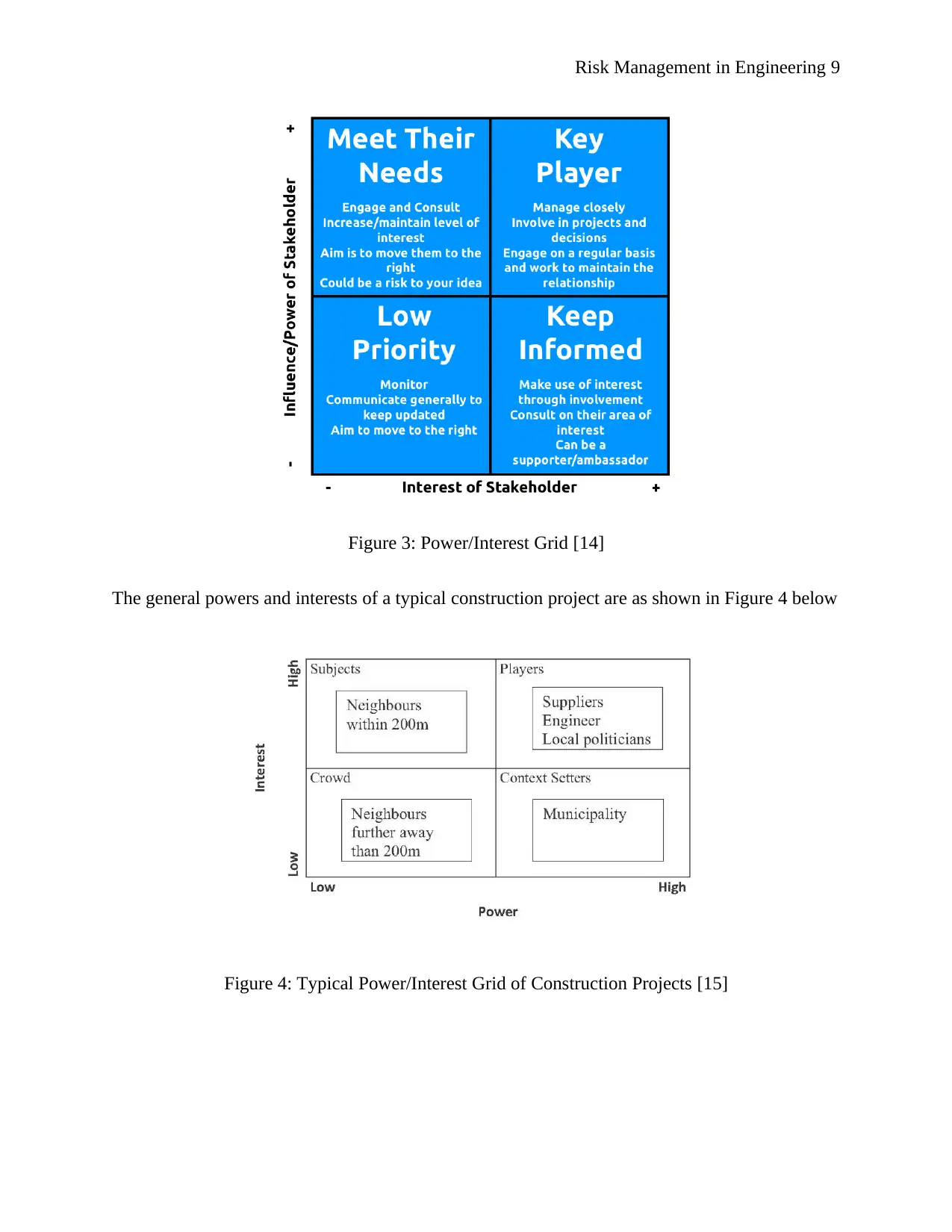
Risk Management in Engineering 9
Figure 3: Power/Interest Grid [14]
The general powers and interests of a typical construction project are as shown in Figure 4 below
Figure 4: Typical Power/Interest Grid of Construction Projects [15]
Figure 3: Power/Interest Grid [14]
The general powers and interests of a typical construction project are as shown in Figure 4 below
Figure 4: Typical Power/Interest Grid of Construction Projects [15]
⊘ This is a preview!⊘
Do you want full access?
Subscribe today to unlock all pages.

Trusted by 1+ million students worldwide
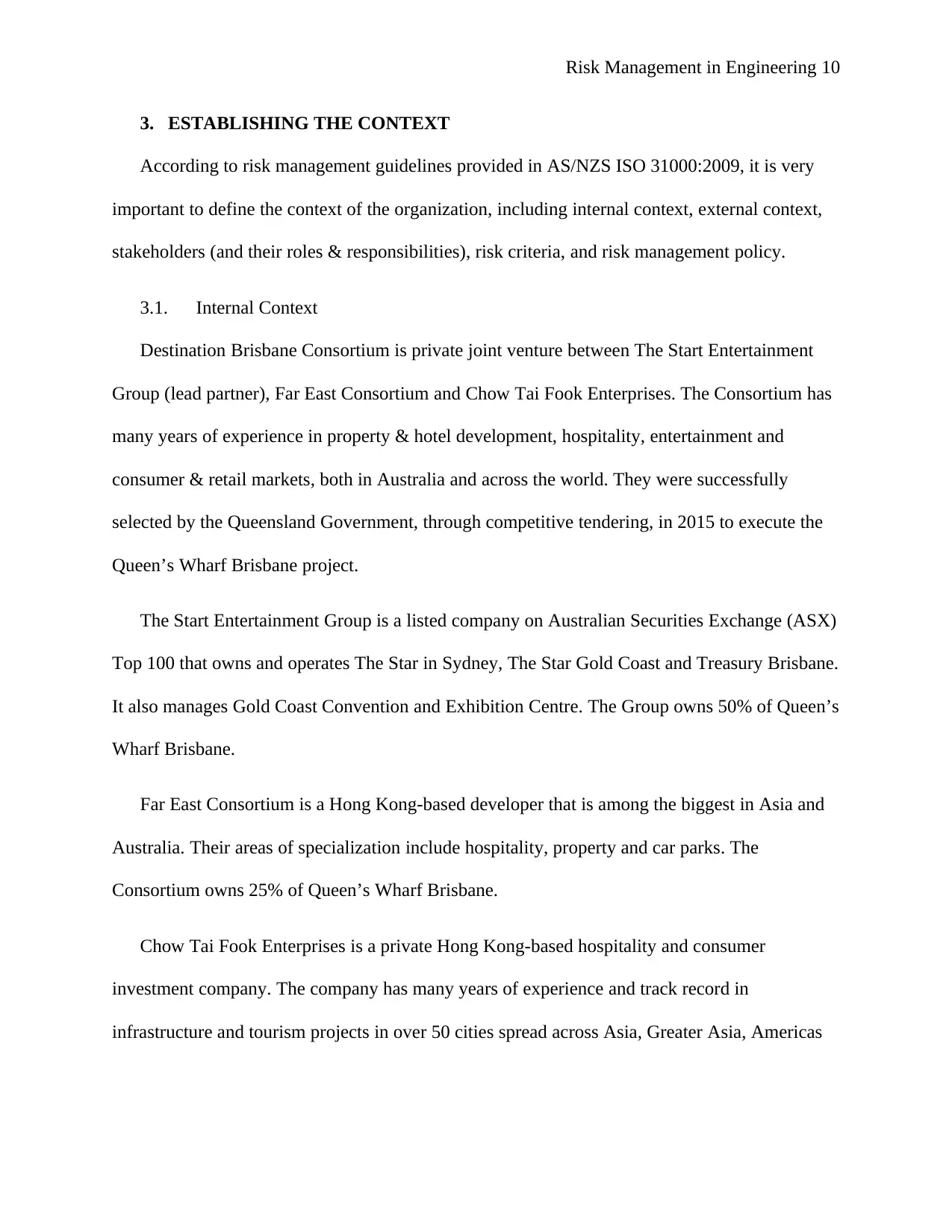
Risk Management in Engineering 10
3. ESTABLISHING THE CONTEXT
According to risk management guidelines provided in AS/NZS ISO 31000:2009, it is very
important to define the context of the organization, including internal context, external context,
stakeholders (and their roles & responsibilities), risk criteria, and risk management policy.
3.1. Internal Context
Destination Brisbane Consortium is private joint venture between The Start Entertainment
Group (lead partner), Far East Consortium and Chow Tai Fook Enterprises. The Consortium has
many years of experience in property & hotel development, hospitality, entertainment and
consumer & retail markets, both in Australia and across the world. They were successfully
selected by the Queensland Government, through competitive tendering, in 2015 to execute the
Queen’s Wharf Brisbane project.
The Start Entertainment Group is a listed company on Australian Securities Exchange (ASX)
Top 100 that owns and operates The Star in Sydney, The Star Gold Coast and Treasury Brisbane.
It also manages Gold Coast Convention and Exhibition Centre. The Group owns 50% of Queen’s
Wharf Brisbane.
Far East Consortium is a Hong Kong-based developer that is among the biggest in Asia and
Australia. Their areas of specialization include hospitality, property and car parks. The
Consortium owns 25% of Queen’s Wharf Brisbane.
Chow Tai Fook Enterprises is a private Hong Kong-based hospitality and consumer
investment company. The company has many years of experience and track record in
infrastructure and tourism projects in over 50 cities spread across Asia, Greater Asia, Americas
3. ESTABLISHING THE CONTEXT
According to risk management guidelines provided in AS/NZS ISO 31000:2009, it is very
important to define the context of the organization, including internal context, external context,
stakeholders (and their roles & responsibilities), risk criteria, and risk management policy.
3.1. Internal Context
Destination Brisbane Consortium is private joint venture between The Start Entertainment
Group (lead partner), Far East Consortium and Chow Tai Fook Enterprises. The Consortium has
many years of experience in property & hotel development, hospitality, entertainment and
consumer & retail markets, both in Australia and across the world. They were successfully
selected by the Queensland Government, through competitive tendering, in 2015 to execute the
Queen’s Wharf Brisbane project.
The Start Entertainment Group is a listed company on Australian Securities Exchange (ASX)
Top 100 that owns and operates The Star in Sydney, The Star Gold Coast and Treasury Brisbane.
It also manages Gold Coast Convention and Exhibition Centre. The Group owns 50% of Queen’s
Wharf Brisbane.
Far East Consortium is a Hong Kong-based developer that is among the biggest in Asia and
Australia. Their areas of specialization include hospitality, property and car parks. The
Consortium owns 25% of Queen’s Wharf Brisbane.
Chow Tai Fook Enterprises is a private Hong Kong-based hospitality and consumer
investment company. The company has many years of experience and track record in
infrastructure and tourism projects in over 50 cities spread across Asia, Greater Asia, Americas
Paraphrase This Document
Need a fresh take? Get an instant paraphrase of this document with our AI Paraphraser
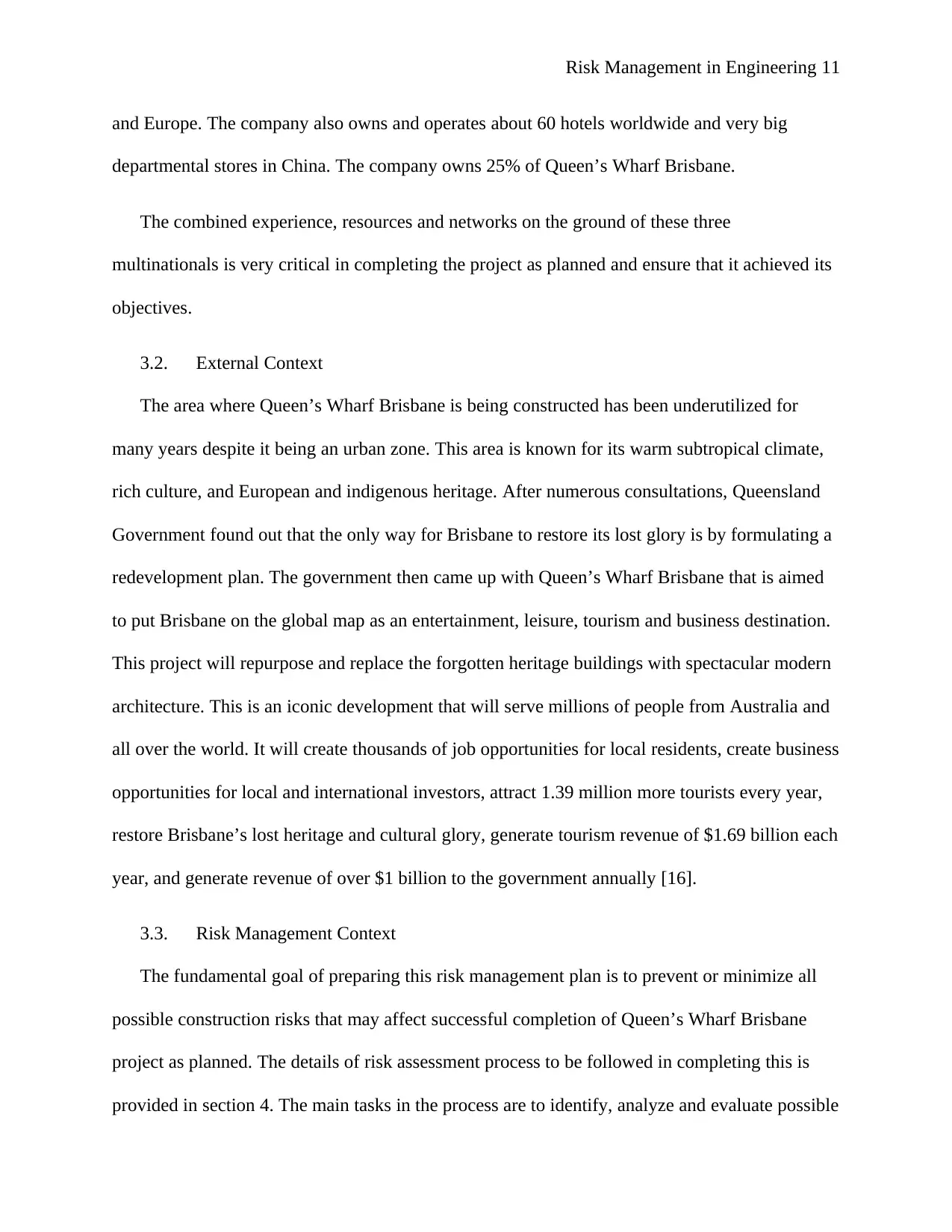
Risk Management in Engineering 11
and Europe. The company also owns and operates about 60 hotels worldwide and very big
departmental stores in China. The company owns 25% of Queen’s Wharf Brisbane.
The combined experience, resources and networks on the ground of these three
multinationals is very critical in completing the project as planned and ensure that it achieved its
objectives.
3.2. External Context
The area where Queen’s Wharf Brisbane is being constructed has been underutilized for
many years despite it being an urban zone. This area is known for its warm subtropical climate,
rich culture, and European and indigenous heritage. After numerous consultations, Queensland
Government found out that the only way for Brisbane to restore its lost glory is by formulating a
redevelopment plan. The government then came up with Queen’s Wharf Brisbane that is aimed
to put Brisbane on the global map as an entertainment, leisure, tourism and business destination.
This project will repurpose and replace the forgotten heritage buildings with spectacular modern
architecture. This is an iconic development that will serve millions of people from Australia and
all over the world. It will create thousands of job opportunities for local residents, create business
opportunities for local and international investors, attract 1.39 million more tourists every year,
restore Brisbane’s lost heritage and cultural glory, generate tourism revenue of $1.69 billion each
year, and generate revenue of over $1 billion to the government annually [16].
3.3. Risk Management Context
The fundamental goal of preparing this risk management plan is to prevent or minimize all
possible construction risks that may affect successful completion of Queen’s Wharf Brisbane
project as planned. The details of risk assessment process to be followed in completing this is
provided in section 4. The main tasks in the process are to identify, analyze and evaluate possible
and Europe. The company also owns and operates about 60 hotels worldwide and very big
departmental stores in China. The company owns 25% of Queen’s Wharf Brisbane.
The combined experience, resources and networks on the ground of these three
multinationals is very critical in completing the project as planned and ensure that it achieved its
objectives.
3.2. External Context
The area where Queen’s Wharf Brisbane is being constructed has been underutilized for
many years despite it being an urban zone. This area is known for its warm subtropical climate,
rich culture, and European and indigenous heritage. After numerous consultations, Queensland
Government found out that the only way for Brisbane to restore its lost glory is by formulating a
redevelopment plan. The government then came up with Queen’s Wharf Brisbane that is aimed
to put Brisbane on the global map as an entertainment, leisure, tourism and business destination.
This project will repurpose and replace the forgotten heritage buildings with spectacular modern
architecture. This is an iconic development that will serve millions of people from Australia and
all over the world. It will create thousands of job opportunities for local residents, create business
opportunities for local and international investors, attract 1.39 million more tourists every year,
restore Brisbane’s lost heritage and cultural glory, generate tourism revenue of $1.69 billion each
year, and generate revenue of over $1 billion to the government annually [16].
3.3. Risk Management Context
The fundamental goal of preparing this risk management plan is to prevent or minimize all
possible construction risks that may affect successful completion of Queen’s Wharf Brisbane
project as planned. The details of risk assessment process to be followed in completing this is
provided in section 4. The main tasks in the process are to identify, analyze and evaluate possible
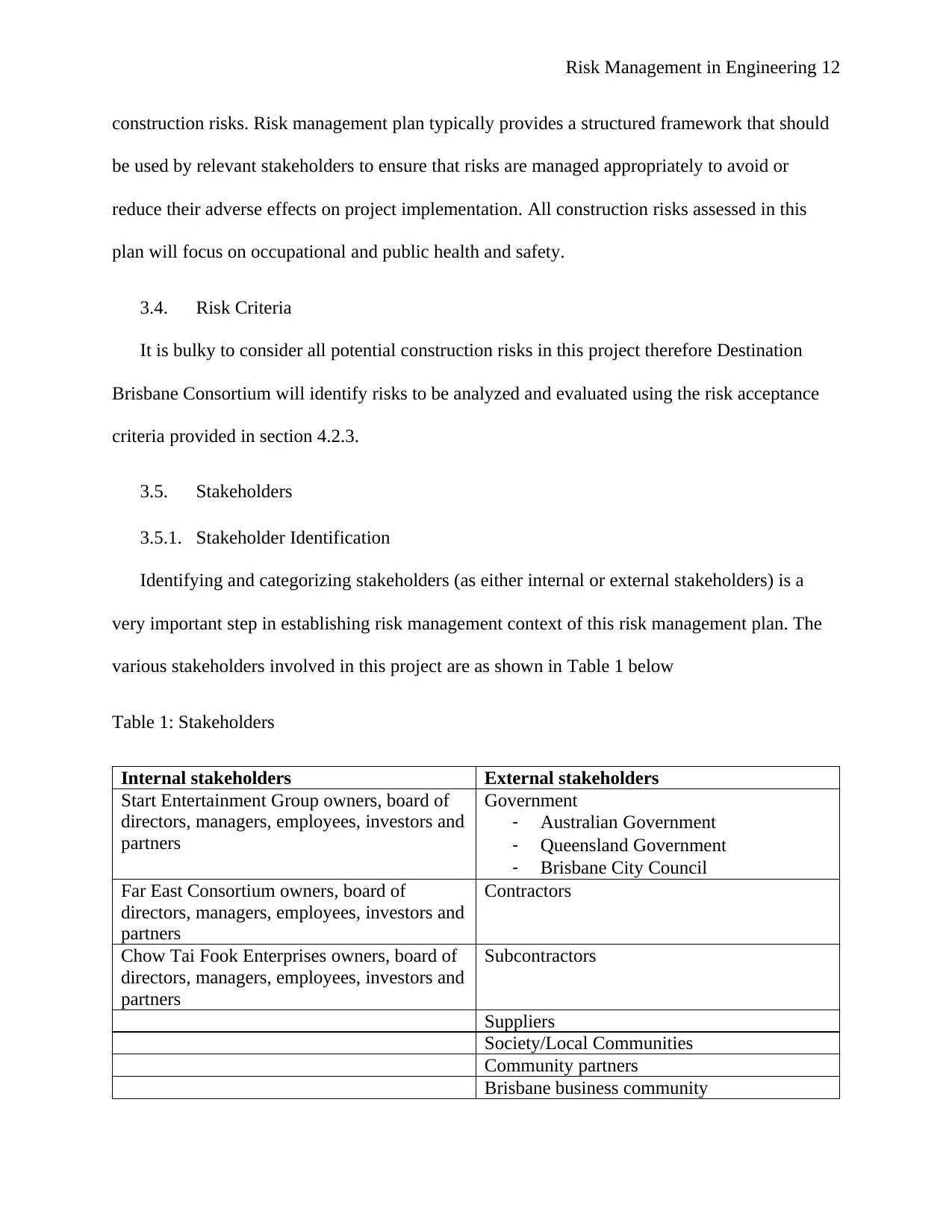
Risk Management in Engineering 12
construction risks. Risk management plan typically provides a structured framework that should
be used by relevant stakeholders to ensure that risks are managed appropriately to avoid or
reduce their adverse effects on project implementation. All construction risks assessed in this
plan will focus on occupational and public health and safety.
3.4. Risk Criteria
It is bulky to consider all potential construction risks in this project therefore Destination
Brisbane Consortium will identify risks to be analyzed and evaluated using the risk acceptance
criteria provided in section 4.2.3.
3.5. Stakeholders
3.5.1. Stakeholder Identification
Identifying and categorizing stakeholders (as either internal or external stakeholders) is a
very important step in establishing risk management context of this risk management plan. The
various stakeholders involved in this project are as shown in Table 1 below
Table 1: Stakeholders
Internal stakeholders External stakeholders
Start Entertainment Group owners, board of
directors, managers, employees, investors and
partners
Government
- Australian Government
- Queensland Government
- Brisbane City Council
Far East Consortium owners, board of
directors, managers, employees, investors and
partners
Contractors
Chow Tai Fook Enterprises owners, board of
directors, managers, employees, investors and
partners
Subcontractors
Suppliers
Society/Local Communities
Community partners
Brisbane business community
construction risks. Risk management plan typically provides a structured framework that should
be used by relevant stakeholders to ensure that risks are managed appropriately to avoid or
reduce their adverse effects on project implementation. All construction risks assessed in this
plan will focus on occupational and public health and safety.
3.4. Risk Criteria
It is bulky to consider all potential construction risks in this project therefore Destination
Brisbane Consortium will identify risks to be analyzed and evaluated using the risk acceptance
criteria provided in section 4.2.3.
3.5. Stakeholders
3.5.1. Stakeholder Identification
Identifying and categorizing stakeholders (as either internal or external stakeholders) is a
very important step in establishing risk management context of this risk management plan. The
various stakeholders involved in this project are as shown in Table 1 below
Table 1: Stakeholders
Internal stakeholders External stakeholders
Start Entertainment Group owners, board of
directors, managers, employees, investors and
partners
Government
- Australian Government
- Queensland Government
- Brisbane City Council
Far East Consortium owners, board of
directors, managers, employees, investors and
partners
Contractors
Chow Tai Fook Enterprises owners, board of
directors, managers, employees, investors and
partners
Subcontractors
Suppliers
Society/Local Communities
Community partners
Brisbane business community
⊘ This is a preview!⊘
Do you want full access?
Subscribe today to unlock all pages.

Trusted by 1+ million students worldwide
1 out of 30
Related Documents
Your All-in-One AI-Powered Toolkit for Academic Success.
+13062052269
info@desklib.com
Available 24*7 on WhatsApp / Email
![[object Object]](/_next/static/media/star-bottom.7253800d.svg)
Unlock your academic potential
Copyright © 2020–2025 A2Z Services. All Rights Reserved. Developed and managed by ZUCOL.





